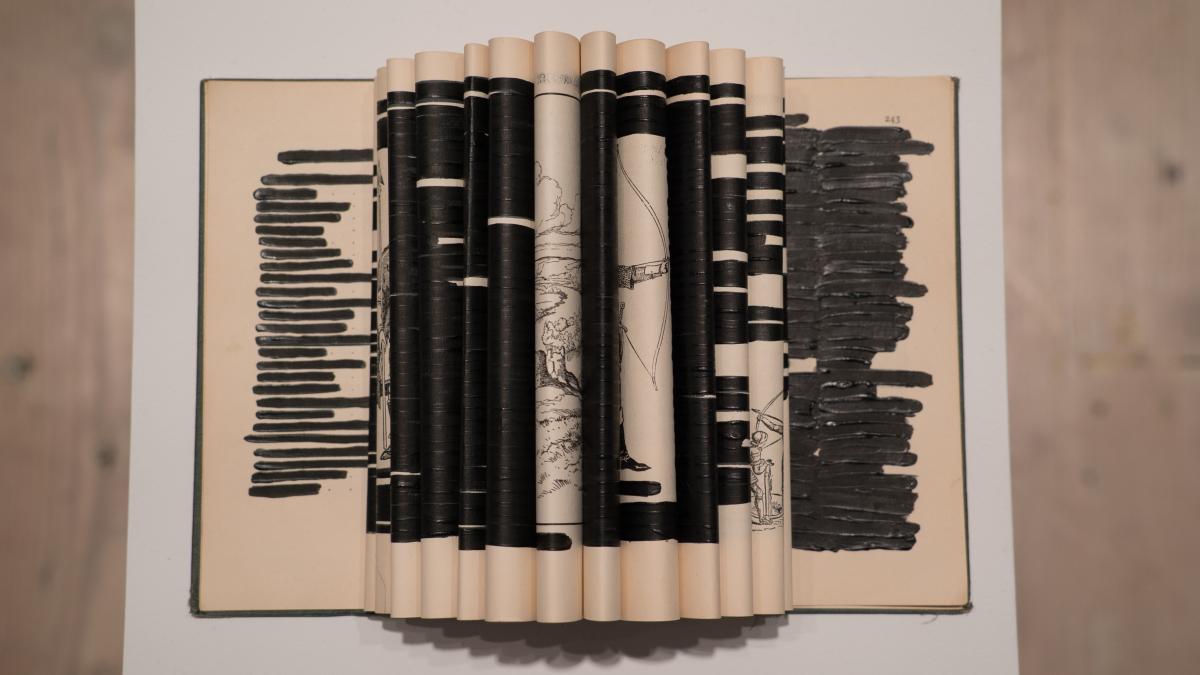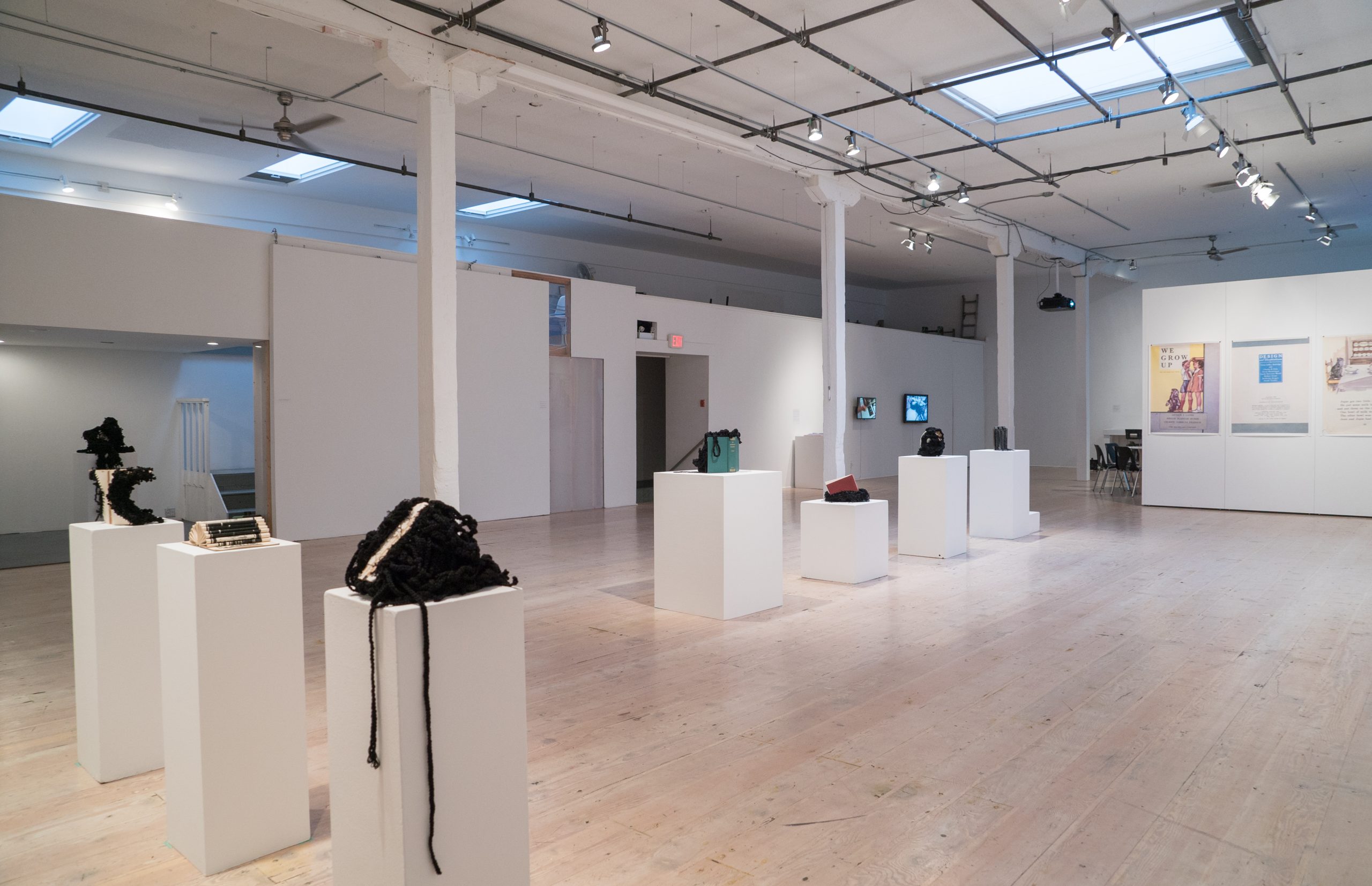Gibson is a Vancouver-based artist and educator whose work plunges into the fraught territory of school texts and history books with a sewing needle and re-works historical Canadian texts with black thread in order to revise our ideas of history, nationhood, and how we read. Through altered book sculptures that ensnare the texts with braids and thread, redacted texts, and reprints of old children’s readers, Gibson’s work asks us to consider the voices, stories, and bodies that have been erased or excluded from historical narratives and proposes material ways in which we can resist those historical erasures
Chantal Gibson is a Vancouver-based artist and educator whose work plunges into the fraught territory of school texts and history books with a sewing needle and re-works historical Canadian texts with black thread in order to revise our ideas of history, nationhood, and how we read. Through altered book sculptures that ensnare the texts with braids and thread, redacted texts, and reprints of old children’s readers, Gibson’s work asks us to consider the voices, stories, and bodies that have been erased or excluded from historical narratives and proposes material ways in which we can resist those historical erasures.
Knowing what I know about Chantal’s work, reading the above description of her exhibit, How She Read: Confronting the Romance of Empire, only solidified my desire to see it for myself. So you can imagine my excitement when I was invited to join her in Victoria to host and participate in the launch. When I first saw the layout, I was speechless. The contrast of the white walls with the black woven and braided threads spoke to me in terms of how much space each occupied and the significance of that.
 As we toured the pieces, each spoke to me differently and various themes and questions arose of their own volition. Themes of racism, micro-aggressions, black women’s representation in history, and the barriers they faced were all at the forefront of the questions forming in my mind. And Open Space, to me, seemed like the perfect home for these questions to be discussed.
As we toured the pieces, each spoke to me differently and various themes and questions arose of their own volition. Themes of racism, micro-aggressions, black women’s representation in history, and the barriers they faced were all at the forefront of the questions forming in my mind. And Open Space, to me, seemed like the perfect home for these questions to be discussed.
Open Space is a non-profit artist-run centre that has been working to support and present contemporary arts in Victoria since its founding in 1972. With Open Space’s interest in developing interdisciplinary projects, they were really excited to work on How She Read, and present a show that lives at the intersection of text and sculptural art.
“Our mandate is to present contemporary arts projects that are challenging, thought-provoking, and self-reflexive, to stimulate and hold space for critical exchange, to engage a multiplicity of communities, and to provide space for artists to develop their practice,” says Kara Stanton, Literary & Program Coordinator at Open Space. “We generally have three main streams of programming: visual and media art, sound and new music, and literary arts. Increasingly we’ve been working to move towards a collaborative curatorial methodology, with the goal that the different aspects of programming can be developed in response to each other to create dynamic and multi-faceted works with multiple access points for folks from different artistic disciplines and communities.”
Not only was I totally enamoured by Chantal’s work, but as an event curator myself, I was very much curious about the planning process. “The installation process for How She Read was a bit intense. The vintage children’s book posters, the multimedia videos and slides and most of the altered books were completed, so most of the hanging and placement I left to Miles–the amazing Open Space technician. But three of the altered books had to be finished on site, including ‘Hyperbole’, the twisted lyric poem and the title piece ‘The Romance of Empire.’ Even though we worked piecemeal and premade sections of the braided sculptures, Ella, my super cool studio assistant and I worked steady for two days—and I finished the final touches about 30 minutes before the opening,” says Gibson.
Kara also acknowledges the careful curation needed to pull something of this nature together. “Planning for an exhibition is a months-long process that involves communicating with the artist and program committee/curatorial team to figure out what the project is and what it will look like, how it can work and take shape in the space. Our programming committee was in transition in the fall, so in the case of Chantal’s work, it largely meant coordinating between me, her, and our Executive Director, Raj.
 There’s also the work of figuring out ways to connect the artist to community (if they are from out of town), organizing events in relation to the show, and promoting it through all the usual media routes. We were really excited to have the chance to collaborate with the Libraries at the University of Victoria; they presented Chantal’s piece TOME in the library on campus for the duration of her show at Open Space, offering the chance for a piece of contemporary artwork to reach students in a space they might not be expecting it,” says Stanton.
There’s also the work of figuring out ways to connect the artist to community (if they are from out of town), organizing events in relation to the show, and promoting it through all the usual media routes. We were really excited to have the chance to collaborate with the Libraries at the University of Victoria; they presented Chantal’s piece TOME in the library on campus for the duration of her show at Open Space, offering the chance for a piece of contemporary artwork to reach students in a space they might not be expecting it,” says Stanton.
Offering the chance for a piece of contemporary artwork to reach students in a space they might not be expecting it . . . fabulous.
Sitting with this for awhile I started to connect not only the important work Canadian artists are creating, but the bonds and connections that bring the literary, art, and other multi-disciplinary worlds together. When I asked Kara how she discovered Chantal’s work, she noted that she came into contact with Chantal’s work in her first presentation at Growing Room in 2017. Struck by the way she engaged with books as tactile objects that could be re-worked and revised through her methods of braiding, knotting, and erasure, she says it was a real turning point in the way she thought about the book as a form and a particular, located technology of knowledge that could be messed with to disrupt and unsettle the histories around it.
 I asked Chantal about being a woman of colour in the arts and how difficult it can be for many different reasons and how making oneself heard is that much more of a necessity. And her reply was just perfect. “I try to share my work, words and ideas with community-building organizations, libraries and arts centres. If my work can help them design activities, promote public events or create teaching curriculums, I’m happy to share it. As a book of poetry, I think How She Read is a good read and a decent contribution to CanLit. I also think the poems are useful tools for engaging readers in conversations about race, gender and national identity.”
I asked Chantal about being a woman of colour in the arts and how difficult it can be for many different reasons and how making oneself heard is that much more of a necessity. And her reply was just perfect. “I try to share my work, words and ideas with community-building organizations, libraries and arts centres. If my work can help them design activities, promote public events or create teaching curriculums, I’m happy to share it. As a book of poetry, I think How She Read is a good read and a decent contribution to CanLit. I also think the poems are useful tools for engaging readers in conversations about race, gender and national identity.”
Art is more than just what the artist wants to explain to us, there’s something very visceral about coming into your own experience and recognizing that the way you engage with it is just as important. My takeaways? Art can dismantle, disrupt, rework and challenge the written histories as we’ve come to know them. When I asked Chantal what types of conversations she hoped would emerge from her exhibit, she said, “I’m interested in imagining voices unheard, erased and silenced. I think I use connotatively rich materials in interesting ways—old books, altered text, black thread, black paint, photos, canvas, videos–ways that layer the work and leave interpretation and meaning open to the viewer. You can enjoy each piece (or not) on an aesthetic level level or sink much deeper into the social, cultural and political implications of the collection.During my residency I talked to a couple that brought their adolescent son to the show. We looked at The Braided Book (2011) together. For me, personally, it’s about my mom as young girl looking for her ancestors, the missing Black Loyalists. When the dad said “I think it’s about the long history of the Indigenous people being cut out of Canadian history”—I said, yes, exactly.”
Chantal Gibson is an artist-educator interested in the cultural production of knowledge. Her work explores the overlap between literary and visual art, challenging imperialist notions quietly embedded in everyday thing. Last year her work appeared at the ROM in Toronto and the Montreal Museum of Fine Arts. Recently, she had exhibitions bookending the country—in BC and Nova Scotia. Both were based on her first book How She Read, a CBC books favourite for spring, published by Caitlin Press. How She Read is an extension of her artistic practice. Sculpting black text against a white page, her poems forge new spaces that bend and twist English grammar rules while confronting historic representations of Black womanhood and Otherness in the Canadian cultural imagination. Author Lawrence Hills says “By turns outraged, elegiac, and loving, Chantal Gibson meditates on blackness, womanhood, betrayal, denial, rehsilience, and freedom. How She Read flings open the back door to Canada. It sparks an inquiry and packs a wallop in every line and on every page.”
Recently named one of CBC’s 6 Black writers to watch in 2019, Gibson is an award-winning teacher in the School of Interactive Arts & Technology at Simon Fraser University.
All photos by Miles Giesbrecht
Photo 1 (header) : Confronting the Romance of Empire. Chantal Gibson exhibition at Open Space Victoria BC
Photo 2: C. Gibson. English History in a New Setting. Redacted Sonnet, 2019. Mixed media altered text. (V. Simms, 1936.)
Photo 3 (left): C. Gibson. Hyperbole. Twisted Lyric, 2019. Mixed media altered text. (I am Persuaded, J. Duguid, 1941.)
Photo 4 (right): C. Gibson. Her. Braided Sestina, 2019. Mixed media altered text. (When She Woke, H. Jordan, 2011).














